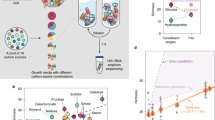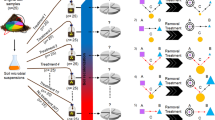Abstract
Bacterial communities provide important services. They break down pollutants, municipal waste and ingested food, and they are the primary means by which organic matter is recycled to plants and other autotrophs. However, the processes that determine the rate at which these services are supplied are only starting to be identified. Biodiversity influences the way in which ecosystems function1, but the form of the relationship between bacterial biodiversity and functioning remains poorly understood. Here we describe a manipulative experiment that measured how biodiversity affects the functioning of communities containing up to 72 bacterial species constructed from a collection of naturally occurring culturable bacteria. The experimental design allowed us to manipulate large numbers of bacterial species selected at random from those that were culturable. We demonstrate that there is a decelerating relationship between community respiration and increasing bacterial diversity. We also show that both synergistic interactions among bacterial species and the composition of the bacterial community are important in determining the level of ecosystem functioning.
This is a preview of subscription content, access via your institution
Access options
Subscribe to this journal
Receive 51 print issues and online access
$199.00 per year
only $3.90 per issue
Buy this article
- Purchase on Springer Link
- Instant access to full article PDF
Prices may be subject to local taxes which are calculated during checkout




Similar content being viewed by others
References
Loreau, M. et al. Biodiversity and ecosystem functioning: Current knowledge and future challenges. Science 294, 804–808 (2001)
Loreau, M. & Hector, A. Partitioning selection and complementarity in biodiversity experiments. Nature 412, 72–76 (2001)
Emmerson, M. C., Solan, M., Emes, C., Paterson, D. M. & Raffaelli, D. Consistent patterns and the idiosyncratic effects of biodiversity in marine ecosystems. Nature 411, 73–77 (2001)
Hooper, D. U. et al. Effects of biodiversity on ecosystem functioning: A consensus of current knowledge. Ecol. Monogr. 75, 3–35 (2005)
Garland, J. L. & Lehman, R. M. Dilution/extinction of community phenotypic characters to estimate relative structural diversity in mixed communities. FEMS Microbiol. Ecol. 30, 333–343 (1999)
Griffiths, B. S. et al. An examination of the biodiversity–ecosystem function relationship in arable soil microbial communities. Soil Biol. Biochem. 33, 1713–1722 (2001)
Franklin, R. B., Garland, J. L., Bolster, C. H. & Mills, A. L. Impact of dilution on microbial community structure and functional potential: Comparison of numerical simulations and batch culture experiments. Appl. Environ. Microbiol. 67, 702–712 (2001)
Yin, B., Crowley, D., Sparovek, G., De Melo, W. J. & Borneman, J. Bacterial functional redundancy along a soil reclamation gradient. Appl. Environ. Microbiol. 66, 4361–4365 (2000)
Fierer, N., Schimel, J. P. & Holden, P. A. Influence of drying-rewetting frequency on soil bacterial community structure. Microb. Ecol. 45, 63–71 (2003)
Cavigelli, M. A. & Robertson, G. P. The functional significance of denitrifier community composition in a terrestrial ecosystem. Ecology 81, 1402–1414 (2000)
Cavigelli, M. A. & Robertson, G. P. Role of denitrifier diversity in rates of nitrous oxide consumption in a terrestrial ecosystem. Soil. Biol. Biochem. 33, 297–310 (2001)
Naeem, S., Hahn, D. R. & Schuurman, G. Producer–decomposer co-dependency influences biodiversity effects. Nature 403, 762–764 (2000)
Griffiths, B. S. et al. The relationship between microbial community structure and functional stability, tested experimentally in an upland pasture soil. Microb. Ecol. 47, 104–113 (2004)
Horz, H. P., Barbrook, A., Field, C. B. & Bohannan, B. J. M. Ammonia-oxidizing bacteria respond to multifactorial global change. Proc. Natl. Acad. Sci. USA 101, 15136–15141 (2004)
Huston, M. A. Hidden treatments in ecological experiments: Re-evaluating the ecosystem function of biodiversity. Oecologia 110, 449–460 (1997)
Kitching, R. L. An ecological study of water-filled tree-holes and their position in the woodland ecosystem. J. Anim. Ecol. 40, 281–302 (1971)
Bell, T. et al. Larger islands house more bacterial taxa. Science 308, 1884 (2005)
van der Heijden, M. G. A. et al. Mycorrhizal fungal diversity determines plant biodiversity, ecosystem variability and productivity. Nature 396, 69–72 (1998)
McGrady-Steed, J., Harris, P. M. & Morin, P. J. Biodiversity regulates ecosystem predictability. Nature 390, 162–165 (1997)
Tilman, D. et al. Diversity and productivity in a long-term grassland experiment. Science 294, 843–845 (2001)
Hector, A. et al. Plant diversity and productivity experiments in European grasslands. Science 286, 1123–1127 (1999)
Curtis, T. F., Head, I. M. & Graham, D. Theoretical ecology for engineering biology. Environ. Sci. Technol. 37, 64A–70A (2003)
Cardinale, B. J., Palmer, M. A. & Collins, S. L. Species diversity enhances ecosystem functioning through interspecific facilitation. Nature 415, 426–429 (2002)
Zengler, K. et al. Cultivating the uncultured. Proc. Natl. Acad. Sci. USA 99, 15681–15686 (2002)
Rappe, M. S. & Giavannoni, S. J. The uncultured microbial majority. Annu. Rev. Microbiol. 57, 369–394 (2003)
Schimel, J. P. & Gulledge, J. Microbial community structure and global trace gases. Global Change Biol. 4, 745–758 (1998)
Sasser, M. MIDI Inc. technical note 101: Identification of bacteria by gas chromatography of cellular fatty acids (Newark, 2001).
Thompson, I. P., Bailey, M. J., Ellis, R. J. & Purdy, K. J. Subgrouping of bacterial-populations by cellular fatty-acid composition. FEMS Microbiol. Ecol. 102, 75–84 (1993)
Cohan, F. M. What are bacterial species? Annu. Rev. Microbiol. 56, 457–487 (2002)
Zibilske, L. M. Methods of Soil Analysis, Part 2. Microbiological and Biochemical Properties 835–863 (SSSA, Madison, 1994)
Acknowledgements
We are grateful to J. Fryxell, T. Nudds and their graduate students for providing comments on the original manuscript, to A. Singer for help developing the technique to measure bacterial respiration, and the Centre for Ecology and Hydrology in Oxford for providing the laboratory space. T. B. was supported by Fonds quebecois de la recherche sur la nature et les technologies, the Natural Sciences and Engineering Council of Canada, and the Clarendon Fund (Oxford University).Author contributions The experiment was originally conceived by T.B., J.A.N. and A.K.L. The laboratory work was conducted by T.B. with the help of A.K.L. and S.L.T. The experimental design was conceived by A.K.L. and developed by T.B., J.A.N. and B.W.S. The statistical analyses were performed by B.W.S. and T.B. The manuscript was written principally by T.B. with extensive input from J.A.N., B.W.S. and A.K.L.
Author information
Authors and Affiliations
Corresponding author
Ethics declarations
Competing interests
Reprints and permissions information is available at npg.nature.com/reprintsandpermissions. The authors declare no competing financial interests.
Supplementary information
Supplementary Discussion
This file contains discussion of additional analysis of the experiment in which we take a detailed look at the interaction between species composition and species richness. (PDF 19 kb)
Supplementary Table S1
This files contains a list of the species level identities used in the experiment. (PDF 13 kb)
Supplementary Table S2
This files contains an outline of the experiment design. (PDF 15 kb)
Supplementary Figure S1
This file contains a figure showing the relationship between the effect of each species on respiration and sensitivity of that effect to the level of diversity. (PDF 19 kb)
Rights and permissions
About this article
Cite this article
Bell, T., Newman, J., Silverman, B. et al. The contribution of species richness and composition to bacterial services. Nature 436, 1157–1160 (2005). https://doi.org/10.1038/nature03891
Received:
Accepted:
Issue Date:
DOI: https://doi.org/10.1038/nature03891
This article is cited by
-
Bacterial wilt affects the structure and assembly of microbial communities along the soil-root continuum
Environmental Microbiome (2024)
-
Sugarcane cultivation altered soil nitrogen cycling microbial processes and decreased nitrogen bioavailability in tropical Australia
Journal of Soils and Sediments (2024)
-
The selection of copiotrophs may complicate biodiversity-ecosystem functioning relationships in microbial dilution-to-extinction experiments
Environmental Microbiome (2023)
-
Soil horizons regulate bacterial community structure and functions in Dabie Mountain of the East China
Scientific Reports (2023)
-
Environmental changes associated with drying climate are expected to affect functional groups of pro- and microeukaryotes differently in temporary saline waters
Scientific Reports (2023)
Comments
By submitting a comment you agree to abide by our Terms and Community Guidelines. If you find something abusive or that does not comply with our terms or guidelines please flag it as inappropriate.



